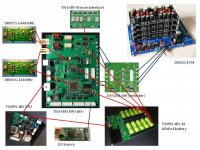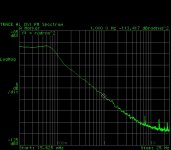Indeed, SMA cables... I zoomed ! And saw the packet is marked "Superbat"... your last cv-19 high RF provider...
BOMs update
A few minor updates of the Mouser BOMs for semi-finished boards:
- TWTMC-EXO 22.5792 MHz and 24.576 MHz, R24 and R25 were inverted in the previous BOMs
- TWTMC-DRIXO 12.288 MHz and 25MHz, C28-C38 better tuned values (in case the oscillators don't start with the values indicated in the previous BOMs)
A few minor updates of the Mouser BOMs for semi-finished boards:
- TWTMC-EXO 22.5792 MHz and 24.576 MHz, R24 and R25 were inverted in the previous BOMs
- TWTMC-DRIXO 12.288 MHz and 25MHz, C28-C38 better tuned values (in case the oscillators don't start with the values indicated in the previous BOMs)
Attachments
Can I ask about PSU. In particular for my TWTMC PPG.
We are often told in the psu section of the forum about keeping the load as close as possible to the psu output. With the products in this GB and with the recommended Hammond enclosures we are obviously being advised to put the oscillator and psu in separate boxes.
I assume this has something to do with EMI from the psu effecting the crystal? My PPG will be powered by Salas Ref D and so I am planning the build!
And just an observation whilst exploring cable options for the clock. I will be feeding into Ians Fifo with his dac and IV stacked on top. I doubt we have room for the SMA adaptor piece onto the small DIL adaptor PCBs if having the DAC ontop. So I shall use a U.fl here and have to be RG178 cable.
Thanks
We are often told in the psu section of the forum about keeping the load as close as possible to the psu output. With the products in this GB and with the recommended Hammond enclosures we are obviously being advised to put the oscillator and psu in separate boxes.
I assume this has something to do with EMI from the psu effecting the crystal? My PPG will be powered by Salas Ref D and so I am planning the build!
And just an observation whilst exploring cable options for the clock. I will be feeding into Ians Fifo with his dac and IV stacked on top. I doubt we have room for the SMA adaptor piece onto the small DIL adaptor PCBs if having the DAC ontop. So I shall use a U.fl here and have to be RG178 cable.
Thanks
The oscillators are almost a constant load for the psu, so you can place the power supply far from the oscillator without any problem.
The oscillator boards have their own bypass and decoupling on board.
We suggested to shield the oscillators in a box to avoid they catch any EMI/RFI from the ambient, not only from the PSU.
Moreover the aluminum case shields the oscillator from the air motion.
The PPG has u.fl output connnector so you can use it to connect Ian's FIFO.
The oscillator boards have their own bypass and decoupling on board.
We suggested to shield the oscillators in a box to avoid they catch any EMI/RFI from the ambient, not only from the PSU.
Moreover the aluminum case shields the oscillator from the air motion.
The PPG has u.fl output connnector so you can use it to connect Ian's FIFO.
It would be better using separate cases to avoid any interference between the oscillators which operate at different frequencies.
Hello Andrea,
If i wanna use a Roon Nucleus to stream music and to listen to ripped CD on an external HD can you make a simple kind of block diagram of things needed to provide the DDDAC with a I2s signal. Not a complete wiring diagram but just the different elements to get a nice sound ( perhaps some extra gimmicks in brackets for improvement)
The element discussed in this thread being one of them ( for oscillastors i understand better have an extra copper/aluminium chassis)
greetings, eduard
If i wanna use a Roon Nucleus to stream music and to listen to ripped CD on an external HD can you make a simple kind of block diagram of things needed to provide the DDDAC with a I2s signal. Not a complete wiring diagram but just the different elements to get a nice sound ( perhaps some extra gimmicks in brackets for improvement)
The element discussed in this thread being one of them ( for oscillastors i understand better have an extra copper/aluminium chassis)
greetings, eduard
I attach a picture I have already posted in a thread (I don't remember which thread).
I don't know if Roon Nucleus outputs I2S over HDMI, if so you can connect it to the FIFO Lite using the TWSAFB-RX receiver.
Otherwise I believe you have to use a USB to I2S converter or something else to convert the output to I2S format.
I don't know if Roon Nucleus outputs I2S over HDMI, if so you can connect it to the FIFO Lite using the TWSAFB-RX receiver.
Otherwise I believe you have to use a USB to I2S converter or something else to convert the output to I2S format.
Attachments
Hello Andrea,
This a copy and paste from a DDDAC thread post recently posted.
I spent many weeks conducting A-B testing to hear the differences between my WaveIO path with my very expensive Lumin streamer as a source and comparing it to my Pi3
Both paths were sent the same music in total sync using Roon. The outputs of both paths were switched by remote controlled relays and the music then went to Ian FiFoPi which went directly into the I2S of the DDDAC
There sound was totally the same and I listened for weeks with different music.
The streamer was sold and WaveIO removed
Thanks and greetings, Eduard
This a copy and paste from a DDDAC thread post recently posted.
I spent many weeks conducting A-B testing to hear the differences between my WaveIO path with my very expensive Lumin streamer as a source and comparing it to my Pi3
Both paths were sent the same music in total sync using Roon. The outputs of both paths were switched by remote controlled relays and the music then went to Ian FiFoPi which went directly into the I2S of the DDDAC
There sound was totally the same and I listened for weeks with different music.
The streamer was sold and WaveIO removed
Thanks and greetings, Eduard
Is there by chance somewhere I missed any drill template dimensions for the preparing the metal box end plates?
What do you think of this clock unit?
-120bd at 1Hz for a 10mhz clock is extremely low, even lower than the 5mhz SC-cut clock.
MUTEC - Professional A/V and High-End Equipment - REF10 SE120
-120bd at 1Hz for a 10mhz clock is extremely low, even lower than the 5mhz SC-cut clock.
MUTEC - Professional A/V and High-End Equipment - REF10 SE120
Hello.
Even if you are convinced that the clock is the most important part in the complete collection of circuits/boxes needed to supply your analogue system with some music it is still an expensive part. I cant imagine myself buying one before the end of this year.
Greetings, Eduard
Even if you are convinced that the clock is the most important part in the complete collection of circuits/boxes needed to supply your analogue system with some music it is still an expensive part. I cant imagine myself buying one before the end of this year.
Greetings, Eduard
What do you think of this clock unit?
-120bd at 1Hz for a 10mhz clock is extremely low, even lower than the 5mhz SC-cut clock.
MUTEC - Professional A/V and High-End Equipment - REF10 SE120
I see several problems.
First the performance claim seems extremely exaggerated. I would not believe it without independent verification.
Second 10 MHz does not become low noise audio clocks very easily. You need a fractional PLL and a really low noise VCO/VCXO to turn it into some multiple of 44.1KHz/48KHz to be useful.
Maybe it could be interesting for a DAC using asynchronous sample rate conversion, for those the DAC clock frequency should preferably have nothing to do with multiples of 44.1 kHz or 48 kHz.
I see several problems.
First the performance claim seems extremely exaggerated. I would not believe it without independent verification.
Second 10 MHz does not become low noise audio clocks very easily. You need a fractional PLL and a really low noise VCO/VCXO to turn it into some multiple of 44.1KHz/48KHz to be useful.
I am surprised about the low phase noise, this is quite a bit lower than the new 5,6mhz SC-cut clock unit from Andrea.
I am under the assumption that this 10mhz clock cannot better Andrea’s design.
Could it be a way of measuring?
First the performance claim seems extremely exaggerated. I would not believe it without independent verification.
Neither do I. Since I am currently dabbling with oscillators, here's so far my best shot. A 0dB 6.144MHz sine, from a fractional PLL, using a MTI Series 225 VCOCXO (the best of the best, space grade, long live EBay, got it for almost free 😀).
Note: the chart shows L(f), to get S(f) add 3dB. -110dBrad^2 @1Hz and -124dB @ 10Hz is not too shabby, but a far cry from what they are claiming <-120dB @ 1Hz and <-148dB @ 10Hz, I haven't seen such numbers even for sapphire oscillators (normalized to frequency). Note the b-4 break shortly before 0.1Hz.
Attachments
Last edited:
- Status
- Not open for further replies.
- Home
- Source & Line
- Digital Line Level
- The Well Tempered Master Clock - Building a low phase noise/jitter crystal oscillator

